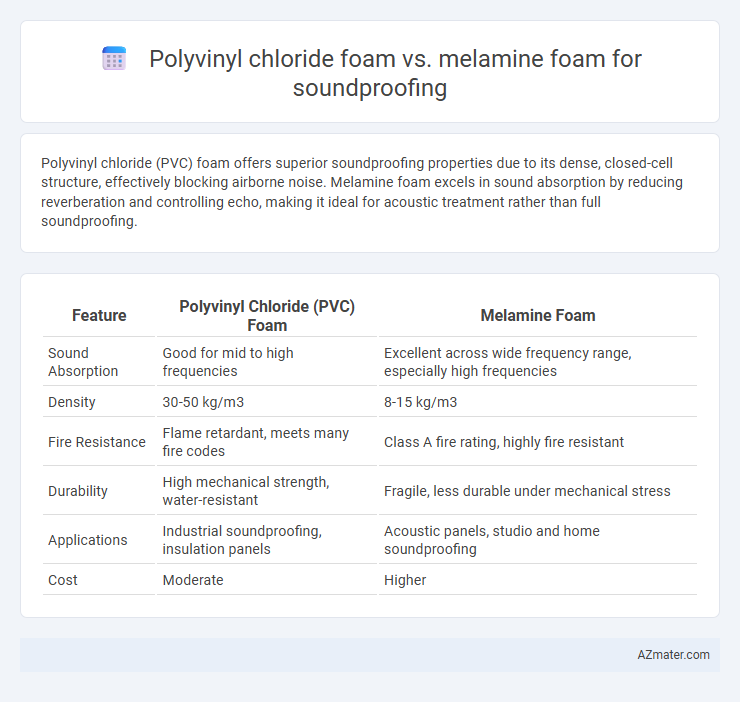Polyvinyl chloride (PVC) foam offers superior soundproofing properties due to its dense, closed-cell structure, effectively blocking airborne noise. Melamine foam excels in sound absorption by reducing reverberation and controlling echo, making it ideal for acoustic treatment rather than full soundproofing.
Table of Comparison
| Feature | Polyvinyl Chloride (PVC) Foam | Melamine Foam |
|---|---|---|
| Sound Absorption | Good for mid to high frequencies | Excellent across wide frequency range, especially high frequencies |
| Density | 30-50 kg/m3 | 8-15 kg/m3 |
| Fire Resistance | Flame retardant, meets many fire codes | Class A fire rating, highly fire resistant |
| Durability | High mechanical strength, water-resistant | Fragile, less durable under mechanical stress |
| Applications | Industrial soundproofing, insulation panels | Acoustic panels, studio and home soundproofing |
| Cost | Moderate | Higher |
Introduction: The Importance of Soundproofing Materials
Polyvinyl chloride (PVC) foam and melamine foam are critical soundproofing materials due to their unique acoustic absorption properties, with PVC foam offering durable, moisture-resistant insulation and melamine foam providing high-performance noise reduction through open-cell structure. Effective soundproofing materials minimize noise pollution in residential, commercial, and industrial environments, improving comfort and productivity. Selection depends on specific acoustic requirements, environmental conditions, and fire resistance standards.
Polyvinyl Chloride Foam: Overview and Properties
Polyvinyl chloride (PVC) foam is a durable and lightweight material widely used for soundproofing due to its excellent acoustic insulation properties and resistance to moisture and chemicals. Its closed-cell structure provides effective noise reduction by absorbing sound waves and minimizing vibration transmission, making it ideal for industrial and commercial applications. PVC foam's fire retardant characteristics and ease of installation further enhance its suitability for soundproofing solutions in diverse environments.
Melamine Foam: Overview and Properties
Melamine foam is a lightweight, open-cell material known for its excellent sound absorption and thermal insulation properties, making it highly effective in noise reduction applications. Unlike polyvinyl chloride foam, melamine foam offers superior breathability and fire resistance, contributing to enhanced indoor air quality and safety. Its porous structure enables it to trap sound waves efficiently, reducing echo and reverberation in spaces such as recording studios, offices, and residential areas.
Sound Absorption Performance: PVC vs Melamine
Polyvinyl chloride (PVC) foam offers moderate sound absorption with dense cellular structure, effectively reducing mid to high-frequency noise but less efficient in low-frequency absorption compared to melamine foam. Melamine foam excels in sound absorption due to its open-cell structure and light density, providing superior performance across a broader frequency range, especially in high frequencies. For optimal soundproofing, melamine foam is preferred for applications targeting enhanced acoustic attenuation and noise control.
Fire Resistance Comparison
Polyvinyl chloride (PVC) foam exhibits superior fire resistance compared to melamine foam, as it is self-extinguishing and releases fewer toxic gases when exposed to flames. Melamine foam, while effective in sound absorption, tends to ignite more easily and produces higher levels of smoke and toxic fumes during combustion. For soundproofing applications requiring stringent fire safety standards, PVC foam offers enhanced protection by combining acoustic insulation with improved fire retardancy.
Durability and Longevity
Polyvinyl chloride (PVC) foam offers superior durability and longevity in soundproofing applications due to its resistance to moisture, chemicals, and physical wear, making it ideal for long-term use in harsh environments. Melamine foam, while effective for acoustic absorption, tends to be less durable, often degrading faster under mechanical stress and exposure to humidity. Choosing PVC foam ensures sustained soundproofing performance over time, especially in settings requiring robust and resilient materials.
Installation and Ease of Use
Polyvinyl chloride (PVC) foam offers straightforward installation due to its rigid structure and ability to be cut into precise shapes, making it ideal for customized soundproofing applications. Melamine foam, known for its lightweight and flexible nature, can be easily compressed and installed in tight or irregular spaces, enhancing ease of use in complex environments. Both materials provide effective sound absorption, but PVC foam generally requires more tools for precise cutting, while melamine foam can be installed with minimal tools and effort.
Cost Analysis: Polyvinyl Chloride vs Melamine Foam
Polyvinyl chloride (PVC) foam generally offers a higher initial cost compared to melamine foam, but its durability and resistance to moisture can lead to lower maintenance expenses over time. Melamine foam is more affordable upfront and excels in absorbing high-frequency sound, making it cost-effective for smaller or temporary soundproofing projects. Evaluating long-term investment versus immediate budget constraints is critical when choosing between PVC and melamine foam for soundproofing applications.
Environmental Impact and Safety
Polyvinyl chloride (PVC) foam emits harmful chemicals such as dioxins during production and disposal, posing environmental risks, whereas melamine foam is more eco-friendly with lower toxicity and better biodegradability. PVC foam contains chlorine, contributing to toxic fumes during fires, while melamine foam offers superior fire resistance with minimal smoke emissions, enhancing safety in soundproofing applications. Both materials provide effective acoustic insulation, but melamine foam is favored for sustainable and safer soundproofing solutions.
Which Foam Is Best for Soundproofing?
Polyvinyl chloride (PVC) foam and melamine foam differ significantly in soundproofing effectiveness; melamine foam excels at absorbing mid to high-frequency sounds due to its open-cell structure, making it ideal for reducing echo and reverberation in rooms. PVC foam, while denser and more rigid, provides better sound blocking by physically impeding sound transmission, especially at low frequencies, but lacks superior absorption qualities. For comprehensive soundproofing, melamine foam is best for acoustic treatment and noise absorption, whereas PVC foam is preferable for impact noise reduction and sound insulation.

Infographic: Polyvinyl chloride foam vs Melamine foam for Soundproofing
 azmater.com
azmater.com